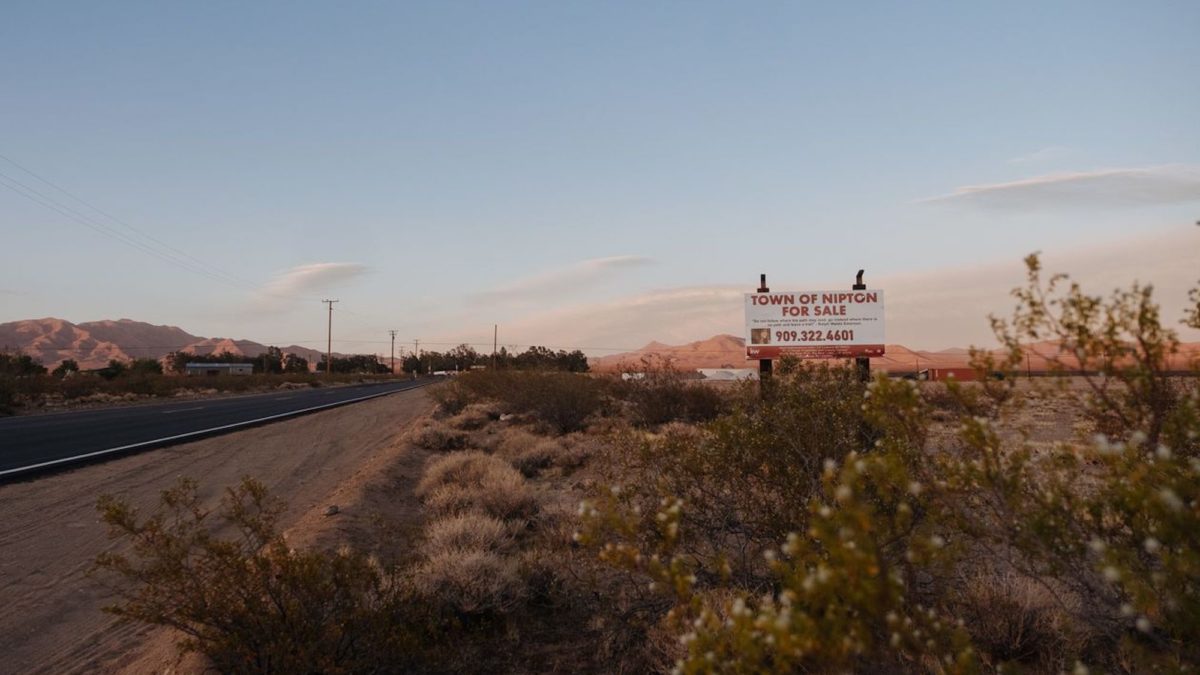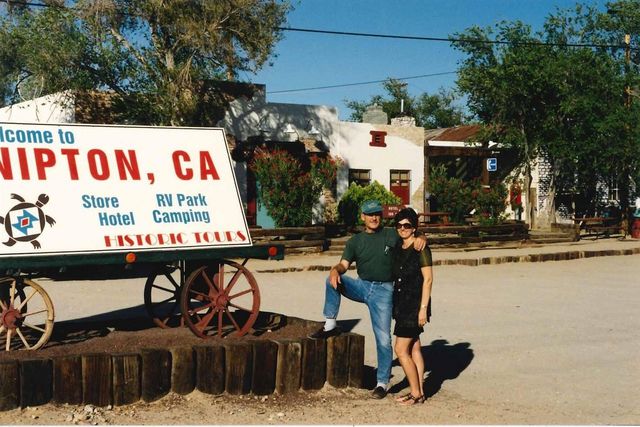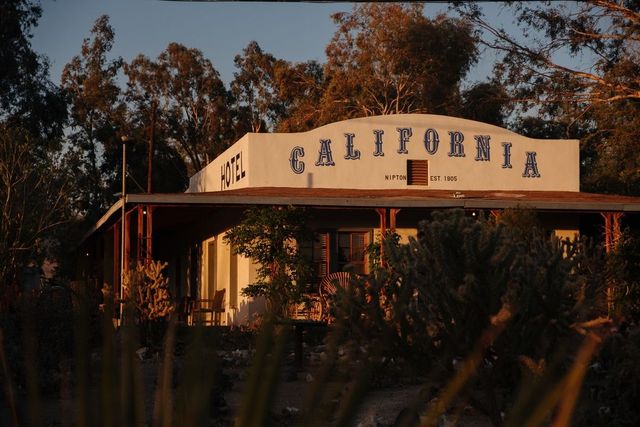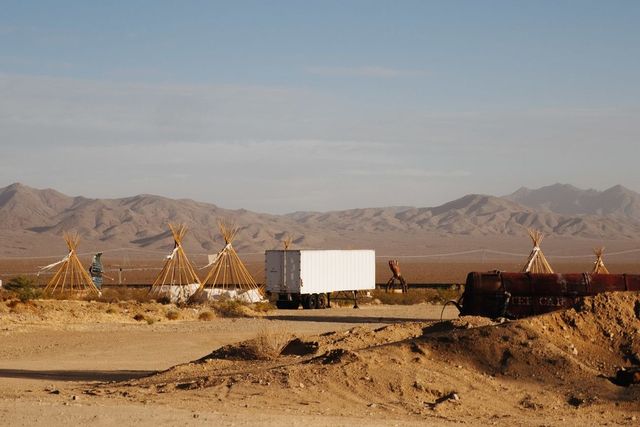
Angela Owens/The Wall Street Journal
NIPTON, Calif.—In the award-winning television show “Schitt’s Creek,” the owners of the tiny town of the same name try to sell it, with no luck. Roxanne Lang feels like she’s been living that story line on repeat.
For more than half a decade now, she has been trying to sell her own town, an 80-acre plot of land on the California side of the Mojave Desert, about an hour away from Las Vegas. It’s now on the market again for $2.75 million.
With almost nothing around it for miles, Nipton is located far off Interstate 15, and appears in the middle of the desert almost like a mirage, with a grove of eucalyptus trees marking its presence.
It is home to 25 residents—give or take—a general store, an old schoolhouse, a trailer park, some art structures trucked in from Nevada’s Burning Man festival, and a ghost of a Nipton owner from a century ago, named Harry. The ghost, say residents, often appears in a midthigh coat and a black cowboy hat, looking away.

Roxanne Lang
Ms. Lang, who has owned the town along with her husband, Jerry Freeman, since 1985, first put it up for sale after Mr. Freeman died in 2016. It was Mr. Freeman, a gold prospector, who fell in love with Nipton, calling her at their home in Malibu to surprise her with the news that he had purchased the dusty acreage and all its structures for about $200,000.
“My first response was, ‘promise me we don’t have to live there,’ ” Ms. Lang, a retired speech-language pathologist, recalled. She ended up there for about 30 years, raising a son.
When the family first arrived, Nipton was an even dustier, more desolate outpost than it is today. The prior owners had placed dummies around the property to make it look like there were a lot of people living there. There weren’t—and the one resident soon left.

Angela Owens/The Wall Street Journal
Ms. Lang and Mr. Freeman planted the grove of desert-adapted eucalyptus trees and refurbished the small cafe and a five-room adobe hotel—now called Hotel California. They built several tiny eco-cabins for visitors. “It probably would have been easier to bulldoze it,” Ms. Lang says. The property includes the house where Ms. Lang and Mr. Freeman once lived.
In 2017, American Green, a cannabis company that trades over-the-counter, bought the town for about $5 million, with part of the financing from Ms. Lang. The company hoped to turn it into an event space for Instagram influencers showcasing marijuana products, and other weed tourists. The company erected some tepees and trucked in the Burning Man art, including a metal UFO and a giant circle made out of shopping carts stacked together.
American Green had organized just one or two events in Nipton and tried to build a swimming pool when a subsidiary company they sold it to stopped making payments. Ms. Lang says she tried to work with the group for more than a year, before she was forced to foreclose. The pandemic slowed down the process even more.
David G. Gwyther, the president of American Green, says in an interview that the company faced unforeseen costs in Nipton and “many unexpected complications.”
“No matter how good your intentions, the path toward success many times leads to failure,” he says.
Towns aren’t an easy thing to sell, as the fictional Rose family from “Schitt’s Creek” discovered. The once-wealthy family initially tried to sell the bare-bones town of Schitt’s Creek but eventually learned to love it instead. The actors portraying the Rose family weren’t available to comment on the challenge, according to their reps. Ms. Lang says Nipton is much more charming than Schitt’s Creek.

Angela Owens/The Wall Street Journal

Angela Owens/The Wall Street Journal
In real life, the town of Cal-Nev-Ari, Nev., which had also been on the market for about five years for about $8 million, recently sold at an undisclosed price, motel and casino included, according to its new owner. Herman Everett put his Texas ghost town called Villa de la Mina for sale about a year ago for $1.75 million, and says he still hasn’t found the right buyer. The property, once home to a popular chili cook-off in the mid-1980s, now features some empty structures made of rock and an old mine.
Mr. Everett says he is hoping to find someone to plow money into the property and bring it back to its former glory. A website advertising the ghost town says he is considering “all offers, trades, partnership options and partial owner financing.”
Back on the market earlier this year, Nipton has seen a variety of prospective buyers, including a group of believers in the existence of a ninth planet, who thought it would make a good place to hide out when the planet’s gravitational pull causes world-wide chaos, says Stephen Shearin, the town’s caretaker.
Mr. Shearin clarifies that he actually is known as Nipton’s “regulator,” while another resident, a former long-haul trucker named Jim Eslinger, is the self-appointed mayor. “I’m grandfathered into the town,” says Mr. Eslinger, who has lived there for 12 years. In truth, the unincorporated community is under the jurisdiction of San Bernardino County, which regulates the businesses on the property and collects taxes.

Kirsten Grind/The Wall Street Journal
On a recent tour this month, it was 90 degrees—the “nice season,” according to Mr. Shearin. In the summer, it can soar to 110 degrees or more. Mr. Shearin pointed out Hotel California and the Nipton Trading Post, both shuttered since the pandemic started.
An old schoolhouse is another community event space sometimes used for yoga or “sound baths,” a type of meditation that includes listening to drums and other musical instruments. The empty cabins built by Ms. Lang and Mr. Freeman “would be perfect for European tourists who want to see the American West,” Mr. Shearin says.
Nipton rarely has crime, residents say. If there are any issues among residents, “we just settle it with a barbecue,” Mr. Shearin says. “We’re very chill out here.” (The San Bernardino County Sheriff’s Department is the real law.)
The town’s motto, hung on signs around the property, is “Magical Nipton.” Some people, like Shannon Salter, who is a part-time resident, agree completely.
“It’s like you’re 100 years in the past and 100 years in the future, and the present, all combined,” says Ms. Salter, a writer. “There is an energy in the desert.” She is hoping to entice 27 other artists to chip in the cost of purchasing the town, turning it into something of an artist’s colony.
Nipton’s real-estate listing isn’t doing it any favors. The advertisement gives a bare-bones description of the property and adds, “Also included is some Desert Art and to top it off, Union Pacific Railroad runs through front of 80 acre property.”
Nipton residents actually consider the train a bonus feature, even though it rumbles through in the middle of the night. “It sounds like it could be coming right through your room!” Ms. Salter says. “It’s so exciting!” Mr. Shearin can tell which conductor is driving by how they blare the train’s horns.
Ms. Lang now splits her time between Southern California and Utah, although she returns sometimes to Nipton, including for a multiday party in late April for all her newly vaccinated friends.
She is currently considering two offers for Nipton, but it is unclear how serious they are. One is an all-cash offer from someone who hasn’t been there.
Updates aren’t happening as fast as they might be—one of her real-estate agents left for five months to hike the Pacific Crest trail. Ms. Lang says she sometimes calls via satellite phone.
The post Schitt’s Creek, but in Real Life: Owner Tries Selling California Desert Town appeared first on Real Estate News & Insights | realtor.com®.
